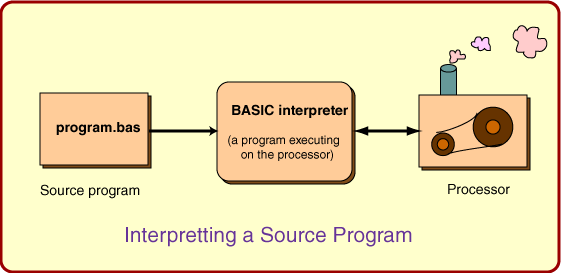Interpreter
Programs written in a high level language are never directly executed by the processor. You have already seen one way to execute such a program: use a translator to create a machine language program that can be executed directly.
Another way to is to use an interpreter for the language. An interpreter is a program that acts like a processor that can directly execute a high level language.
This is a fairly complicated thought. The figure might help:

In this figure, the source program "program.bas" has been written in BASIC (a programming language) by a programmer with a text editor. It is being interpreted by the BASIC interpreter, which is running on the processor. The BASIC interpreter will read each command in the source program and do what it says.
You have probably done this many, many times without realizing it. It is exactly accurate (although an unusual use of the words) to say that the computer game DOOM (or any other game) is an interpreter for the commands that the user enters using the mouse and keyboard. The commands for the game DOOM are not the usual type of commands used in a general purpose programing language, but none the less, they are commands. The set of commands and the rules for how to use them correctly form a programming language for the DOOM interpreter.
When DOOM is running in "demo mode" (a sample game played without user input) it is in fact running a program written in the DOOM language. This program is not being directly processed by the Pentium chip in your computer. The DOOM game is interpretting it command by command.
